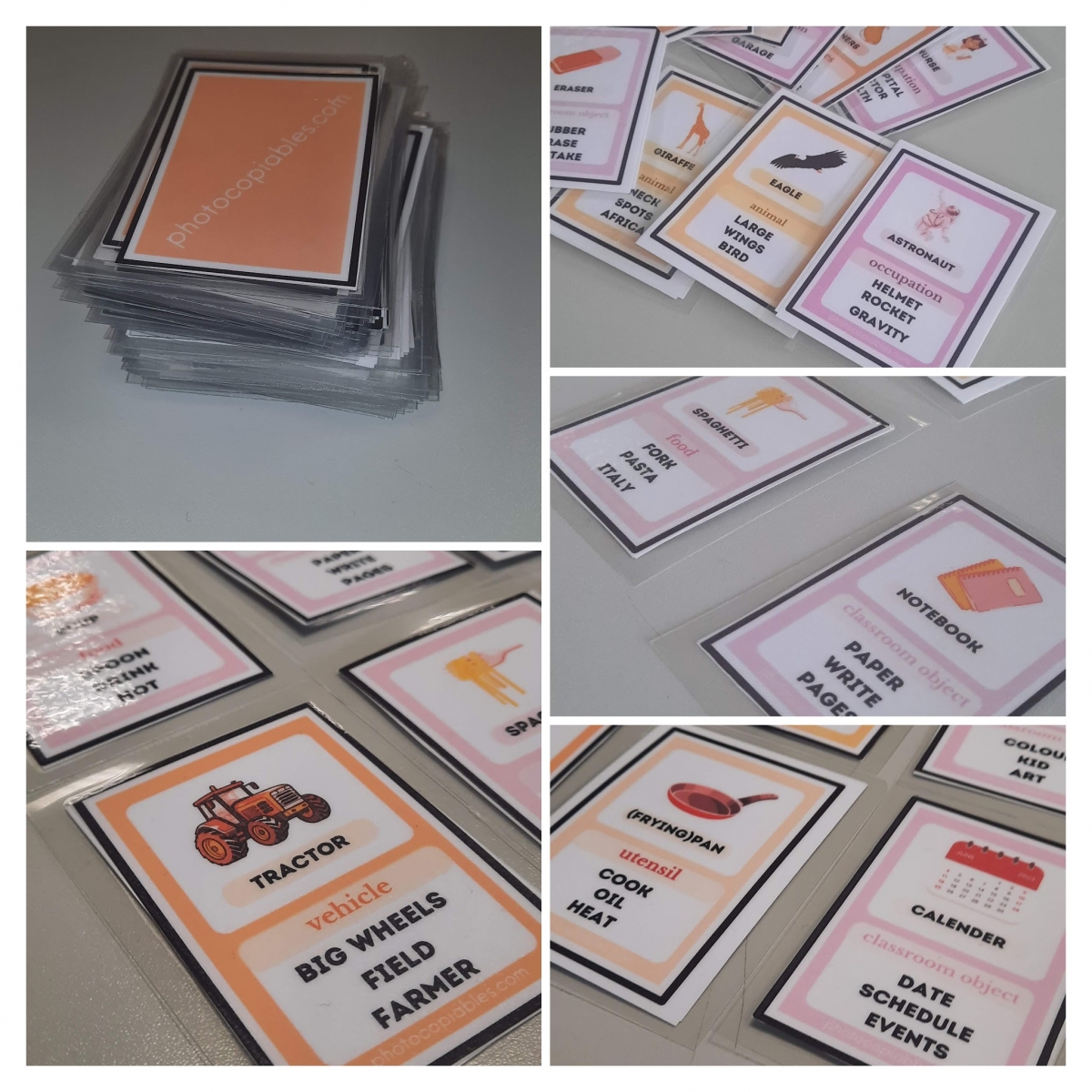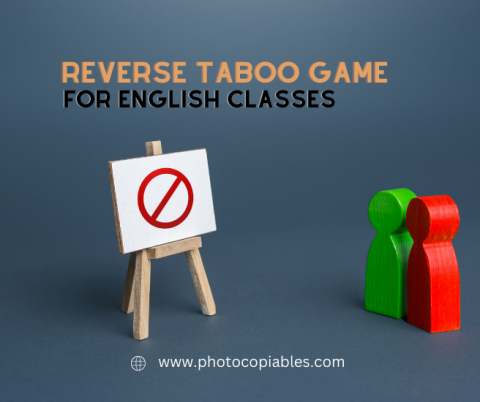Taboo game is one of the challenging games that can be implemented easily in English classes. It’s a great way to practice speaking skills and forces students to use English in a natural way and as much as possible. However, especially in lower-level classes, it becomes quite difficult to play this game as lower-level students can have many problems with sentence forming or vocabulary competency.
The original taboo game is quite straightforward to play. On the taboo game cards, there are some taboo words associated with the target word of the card. After a timer has started, the player tries to describe the target word and their teammates try to guess it correctly. However, while attempting to describe this word, the player should not use taboo words, which makes the game even more challenging besides the description task.
How to Play Reverse Taboo Game
The Reverse Taboo game is a fantastic way to practice speaking in English language classes and it brings a lot of fun time to your classes just like the original game. Besides, it is a much simpler game for English language learners at all levels. In this version of the taboo game, players do use the taboo words to describe the target word. Although it doesn’t look as challenging as the original game, it offers a great opportunity to practice speaking in English language classes. Even low-level students actively join this game and have success in forming simple sentences when the keywords of the target word are given on the card. They don’t have to remember the necessary vocabulary for telling the word on the taboo card. They have to focus on just forming proper sentences. From my own experience, it was awesome to see all class participating in a speaking activity with enthusiasm.
learners at all levels. In this version of the taboo game, players do use the taboo words to describe the target word. Although it doesn’t look as challenging as the original game, it offers a great opportunity to practice speaking in English language classes. Even low-level students actively join this game and have success in forming simple sentences when the keywords of the target word are given on the card. They don’t have to remember the necessary vocabulary for telling the word on the taboo card. They have to focus on just forming proper sentences. From my own experience, it was awesome to see all class participating in a speaking activity with enthusiasm.
The Reverse Taboo is pretty easy to set up. Just make two teams and then give them a certain time to describe the target word. Each player draws a card from the top of the pile of cards and starts to describe the target words in the given time. If the other team member(s) can guess the target words correctly, they get the cards. When all cards are drawn from the set of cards, the team with the most cards is the winner.
A one-minute timer usually works well in most classes. If you have access to a computer in your class, just write “1-minute timer” on Google, and you’ll get a timer on your browser ready and set for one minute. You don’t need to write the scores of the teams in each round. The teams just collect the cards until all the cards are used in the game, and the teams will just count their cards at the end to find out the winner. If a player can not describe a card, then they can say “pass” and continue with the remaining cards in the set.
I’ve prepared a set of Reverse Taboo cards, which you can download below. The cards are grouped around different vocabulary themes, which are occupation, utensil, classroom objects, animals, vehicle, food, accessory and clothes. These categories are also given in the card apart from taboo words. They can also be used to set the context of the word, which will ease the guessing.
How to make the game even simpler
There can be some more strategies to scaffold this speaking activity game. You can help your struggling students to participate more properly in this activity. Here are some example structures to use in the game. You can provide them on the board before the game starts.
- This is a(n) … (a category name)./It is in … category(eg. It’s in the clothes category.)
- You can use it to … (provide a purpose).
- It is a kind/sort of …
- It is like a(n) … / It’s similar to a(n) … (In some cads, the synonyms of the target words are given)
- It’s made of ... (provide the material).
Some suggestions for playing Reverse Taboo
I have some other suggestions for implementing this game in your classes. First of all, you don’t need to try to create equal teams in terms of English competence. As the game is very simplified, the main challenge will be on the ability to describe a word, not the ability to speak fluently or confidently, so I suggest you make players by drawing team A&B cards to form their groups. The team cards are also given below.
Sometimes the number of students in the class can be odd. When you have an odd number of students in your class, then you can either form one group as a bigger group or choose a referee student to check whether the teams obey the rules or not. It is better to choose one of the strong learners to be the referee or you can just let them draw the team cards and the student who gets the referee card becomes the referee in the game. The team A&B cards are also given in the set. You can download and use them.
Sometimes, one team has become evident that they are much stronger in describing. In this case, the game is played very quickly and you can finish it before they run out of cards. Then, you can play a second round in which you can swap some members of the teams to make more or less equal teams.
Finally, don’t forget that some students can become over-competitive when playing games with their friends. So, it is quite important to set the rules strictly before you start to play the game. When they know their borders, it is much more likely that they will behave well during game time in the classroom! By evaluating the competence of your students, you can set the strictness of the rules in the game. You can tell that they are ONLY allowed to use the taboo words (key words) on the cards in their sentences when describing the target words, which will make the game more challenging. On the other hand, in low-level classes, some students cannot even make simple sentences, and have the ability to use only taboo words to make their team members guess the target words. In this way, you can simplify the game a lot more to play.
| Attachment | Size |
|---|---|
| 6.84 MB |






